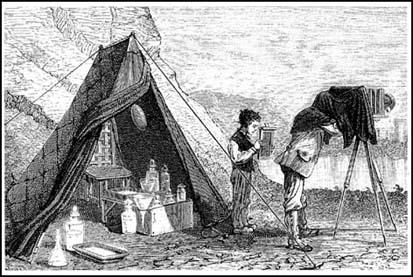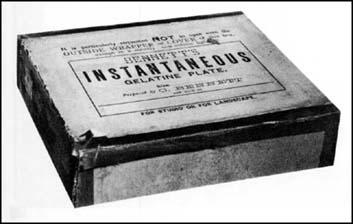|
PART
6 : 'Dry Plate' Photography
The collodion wet plate process produced excellent results,but
had major drawbacks. The photographer had to coat the glass plate
evenly with the sticky collodion solution immediately before use
and each stage of the process - sensitizing, exposing and developing
- had to be done while the plate was still wet. "Wet plate"
photography was difficult enough in the studio and darkroom but
outdoor photography was particularly troublesome. A photographer
who wanted to operate away from his studio would have to carry
with him a large amount of heavy equipment, including glass plates,
a tripod, bottles of chemicals and some sort of portable darkroom,
as well as the bulky camera itself.
Attempts were made in the 1860s to produce 'dry plates'
for photography. Glass plates were either coated with alternate
layers of albumen and collodion or an emulsion of silver bromide
in collodion. The "wet plate" process had to be carried
out in the 10 to 20 minutes it took for the collodion to dry.In
contrast, these pre-coated 'dry plates' could be stored, used
in the camera when required and processed when convenient. However,
these early "dry plates", were not very light sensitive
and required exposure times of up to fifteen minutes.
The search continued for a substance that could bind light sensitive
materials to the glass plates, but allowed fast exposure times.
In 1871, Richard Leach Maddox (1816-1902) a doctor with
a strong interest in photography, proposed the employment of gelatin,
the transparent substance which is used to make jellies. Dr Maddox's
idea was taken up by other experimenters, including Charles
Bennett, who discovered that prolonged heating of the gelatin-silver
bromide emulsion would increase its sensitivity to light. Applying
this method, Bennett was able to produce dry plates with
exposure times of a fraction of a second.
|

[ABOVE]
Photography outside of the studio before the introduction
of photographic "dry plates". This engraving,
which dates from the 1870s, shows the photographer with
his camera on a tripod, his young assistant holding the
"wet collodion plate" in a slide frame, and behind
him a darkroom tent containing a chest of chemicals and
other photographic materials. All this equipment had to
be transported to the location by a photographer using the
"wet collodion " process.
|

[ABOVE] A
pack of Bennett's Instantaneous Gelatine Photographic Plates.
These "dry plates" were manufactured by Charles
Bennett,who perfected the "dry plate" process
in the late 1870s.
|
By
the end of the decade 'gelatine dry plates' were being manufactured
on a large scale. Samuel Fry, a professional photographer
who had been active in Brighton between 1858 and 1860, established
a factory to produce 'ready made' dry plates in the late 1870s.
By 1879, there were more than 14 firms manufacturing "dry
plates". Manufactured gelatin dry plates were evenly coated
by machine and were consistent in quality and could be stored
for weeks or months before exposure and development.
CLICK HERE TO CONTINUE
Instantaneous Photography
Website
last updated: 23 December, 2002
This
website is dedicated to the memory of Arthur T. Gill (1915-1987), Sussex
Photohistorian
|